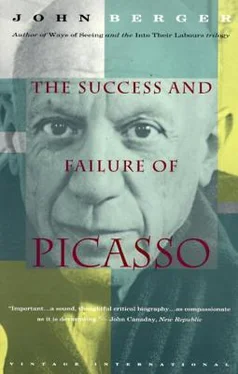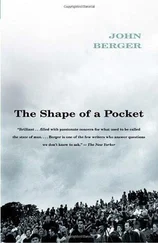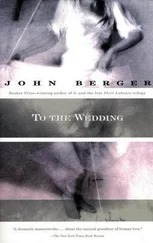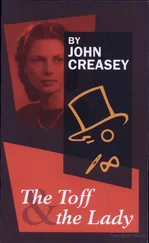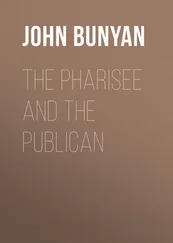The only other artist the extent of whose fame is comparable with Picasso’s is Charlie Chaplin. But Chaplin, like the nineteenth-century painter, became famous because of the popularity of his work. Indeed there are many stories of how his public were disappointed when they saw the real Chaplin because they expected to see Charlie, complete with moustache and walking stick. In Chaplin’s case, the artist — or rather his art — has counted far more than the man. In Picasso’s case the man, the personality, has put his art in the shade. It is too early to explain why this has happened. But it is a point we shall come back to again and again.
You may say that to recognize a name doesn’t amount to recognizing a personality. But everything remembered trails and attracts associations. The associations around Picasso’s name create the legend of the personality. Picasso is an old man who can still get himself young wives. Picasso is a genius. Picasso is mad. Picasso is the greatest living artist. Picasso is a multi-millionaire. Picasso is a communist. Picasso’s work is nonsense: a child could do better. Picasso is tricking us. If Picasso can get away with it all, good luck to him! Such is an average combination of the associations of the name in Europe. The apparent contradictions are possible — even necessary — because daily logic need not and should not apply to mythological characters.
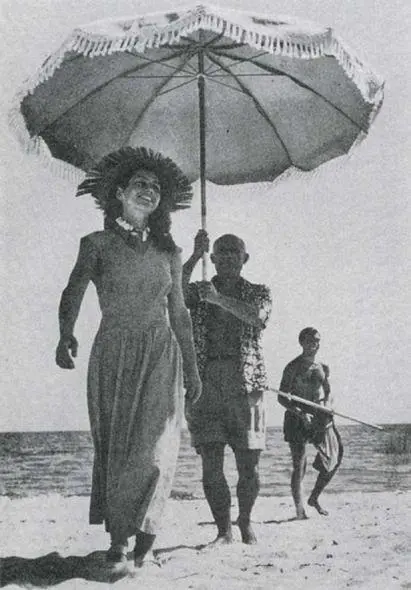
2 Picasso and Françoise Gilot at Golfe Juan, 1948
You suspect I am exaggerating? In the last fifty years under the inhuman pressures within bourgeois society a terrible thirst for unreason has been developed. Jaime Sabartes is Picasso’s life-long companion and semi-official biographer. This is how Sabartes projects Picasso, the man, into the legendary world of the gods:
If Picasso could detain the course of time, all clocks would stop, the hours would perish, days would come to an end, and the earth have to cease its revolutions and wait for him to change his mind. And if it had really been he who had stopped it, the globe would wait in vain. Thus I found Picasso, and thus he must continue. It is necessary for the free pursuit of his destiny. 1
Surprising as it may at first seem, the expert view of Picasso is, in essence, very similar to the popular view. The experts may admire his art, but, whenever they can, they present Picasso as something other than — or more than — a painter.
The Spanish poet Ramon Gomez de la Serna wrote about his friend in 1932:
In Malaga, his native town, I found an explanation of what Picasso is and I understood to what degree he is a toreador — gypsies are the best toreadors — and how, whatever he may do, it is in reality bullfighting.
Jean Cocteau wrote in the late 1950s:
A procession of objects follows in Picasso’s wake, obeying him as the beasts obeyed Orpheus. That is how I would like to represent him: and every time he captivates a new object he coaxes it to assume a shape which he makes unrecognizable to the eye of habit. Our shape-charmer disguises himself as the king of the rag-pickers, scavenging the streets for anything he may find to serve him.
I, more than most, appreciate the difficulty of writing about painting in words and the need for images and metaphors. But the images which Picasso’s friends use all tend to disparage the mere art of painting. The more one reads them, the more one feels that Picasso’s actual works are incidental. One of his friends — Manolo the Spanish sculptor — said this quite simply: ‘For Picasso, you see, painting is a side-issue.’
This would make better sense if Picasso had many other interests, and divided his energies between painting and other activities. It would even make sense if Picasso was an excessively social man who primarily expressed himself in his relationships with other people. But none of this is the case. He is single-minded; he works like a man possessed; and all his relationships are more or less subservient to the needs of his art.
What then is the explanation? Picasso is fascinated by and devoted to his own creativity. What he creates — the finished product — is almost incidental. To some degree this is of course true of all artists: their interest in a work diminishes when it is finished. But in Picasso’s case it is very much more pronounced. It even affects the way he works. He denies that there is such a thing as progress in the creation of a painting: each change, each step, each metamorphosis — as he calls it — is merely a reflection of a new state in him. For Picasso, what he is is far more important than what he does. He projects this priority on to all art:
It’s not what the artist does that counts, but what he is. Cézanne would never have interested me a bit if he had lived and thought like Jacques-Émile Blanche, even if the apples he had painted had been ten times as beautiful. What forces our interest is Cézanne’s anxiety, that’s Cezanne’s lesson; the torments of Van Gogh — that is the actual drama of the man. The rest is a sham. 2
Certainly neither Cézanne nor Van Gogh would have agreed with this. Both, in their different ways, were obsessed by what they produced; both knew that it was by their works and their works alone that their lives might be justified. Cézanne said, ‘The only thing that is really difficult is to prove what one believes. So I am going on with my researches.…’
Picasso’s attitude would, however, have found an echo with the early Romantics — who were indeed the first to formulate it. For them the creative spirit was supreme, and its concrete expressions not just incidental, but a vulgarity.
Heard melodies are sweet, but those unheard
Are sweeter.…
At the beginning of the nineteenth century this was a necessary belief; it was what allowed artists to continue when faced with the way in which the ever more powerful bourgeois world was reducing everything, including art, to a commodity. The creative spirit, genius as a state of being, was celebrated as an end in itself because it alone did not have a price and was unbuyable.
This dualism is now at the very heart of the bourgeois attitude to art. On one hand, the glory and mystery of genius; on the other hand, the work of art as a saleable commodity. You have only to listen to any art dealer today to hear the two in grotesque juxtaposition. The bargaining in guineas, the guarantees of investment, and then the adjectives (‘exciting’, ‘powerful’, ‘extraordinary’, ‘fantastic’) applied to the intangible quality of the work.
It is also implicit in the popular image of the genius — as it is encouraged by untruthful books and films. The genius cannot look after his own material interests (on account of madness, unworldliness, drink), and this inability comes to be seen as a proof of his genius.
One finds the same dualism — the last legacy of this Romantic illusion — in what is now the standardized method of writing art books. The pictures, which the reader can see in the reproductions, are painstakingly described — as though for an inventory. They are treated as stock. Into this description are then inserted the phrases which confer genius on the producer of the pictures. The phrases mount like an incantation. The writer becomes a kind of priest as auctioneer. Here is a typical example:

3 Picasso. An Old Man. 1895
The half-length portrait of an old beggar dating from that time discloses advanced technical skill. There is no doubt that in this as in other related early paintings Picasso was inspired by the great paintings of Velazquez, such as the famous Water Seller of Seville. That is the source of the magnificently realistic rendering of the shining skin, the pasty hair, and the coarse clothing of his model, as well as of the generous, broad brushwork vigorously juxtaposing lights and shadows, which stresses the momentary quality of the figure, and largely contributes to the serious concentrated expression. On the other hand nothing in this picture suggests imitation, let alone copying: like Picasso’s later works, even this youthful painting is characterized by the extraordinary intensity of his own effort. And like all his paintings inspired by historical models, this one reveals a mind that consumes the thing seen in the fire of enthusiasm and recreates it from the ashes as something new that belongs to Picasso alone.… 3
Читать дальше
